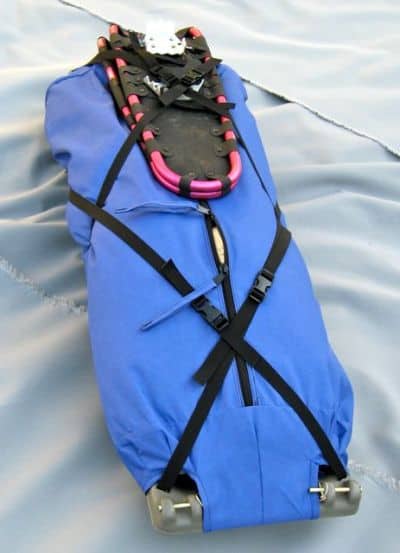SkiPulk’s Snow Clipper
We have mixed experiences using sleds to transport winter camping gear. In the right circumstances a sled offers advantages over backpacking. It easy way to move a lot of gear – up to 18,000 cubic inches and 200+ lbs – more than one can comfortably stash in a backpack. So if you are setting up a base camp, hauling supplies to a cabin or outfitting a scout troop, you might consider a sled. One can just hook into the harness and pull your winter gear rather than carry it.
Sleds work best in the right circumstances. This usually means adequate snow cover and a reasonably level, wide trail. In steep terrain a sled benefits from lashing the gear inside and stiffening of the sleds and/or harnessing. The addition of a rigid harness system is what differentiates a sled from a pulk.
Ed Bouffard, from ED’s Wilderness Systems, knows a lot about using pulks and sleds to transport winter camping gear. He has been designing ski pulks since 1994. He has sold sleds to winter campers and published The Pulk Book, a downloadable pdf book that includes designs, parts resources, and useful information for building your own pulk.
Historically, SkiPulk has offered two high end fiberglass sleds: the Weekender ($420) and the EWS Expedition Pulk ($530) and set ups for Paris Expedition sleds. The fiberglass models are well tested products but the number of winter campers who want to pay the premium and take the extra care of it are few and far between. Over the years SkiPulk has sold hundreds of Paris Expedition sled set ups and people have had extremely positive things to say about them but the fact is that the sled was never made to be a pulk sled.
New for this winter season SkiPulk is offering the Snow Clipper SkiPulk designed to take the best of the over the counter plastic sleds and make something truly unique for pulk use.
Ed reports that the first change was to use a rotomold process rather than less expensive thermo/vacumn process. While a sled like the Paris is thickest on the outside edge and thinnest on the bottom where most wear takes place; rotomolding creates a uniform thickness and it allows “structure to be built into the sled so there is no need for the wide rims a sled like the Paris needs for rigidity.” The result is an extremely durable and more rigid sled with shorter and narrower dimensions that actually has a slightly larger cargo space.
Roto molding allowed built in ski track runners and fittings to attach the poles. A unique addition was to mold in slots to allow a user to make their own divider or child backrests out of 1/2 inch plywood. The last adaptation was to mold in bump outs that allowed the design retractable fins. Fins are great solutions to problems of side hill slippage and control on icy descents but they really add unnecessary friction when not needed. These fins simply pop out of the way when not needed. The Snow Clipper won’t be for everyone. The cost of these extra features and durability is a about 4 extra pounds.
Check out SkiPulk for more information on the Snow Clipper.
SHARE
October 27th, 2009 | Category: Cold Weather Camping, Winter Camping, Winter Camping Gear


